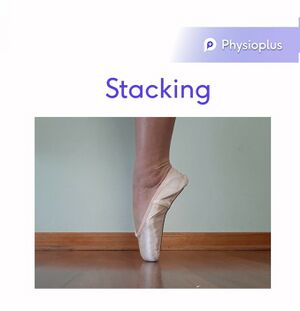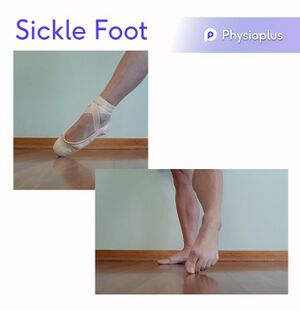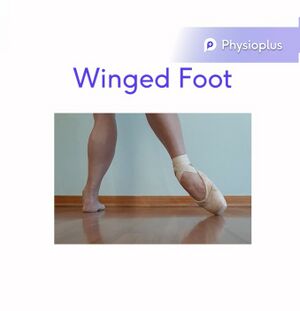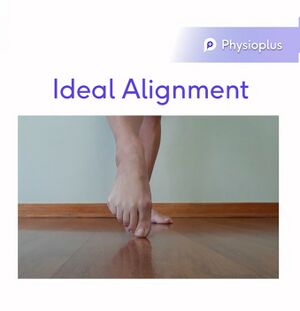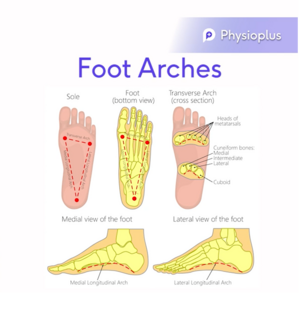Biomechanics of the Dancer’s Ankle and Foot: Difference between revisions
Carin Hunter (talk | contribs) No edit summary |
Carin Hunter (talk | contribs) No edit summary |
||
| Line 4: | Line 4: | ||
Assessing an injury in a ballet patient can be a daunting task. After gaining a basic understanding of the foot and ankle anatomy, applying the biomechanical principles will help form a clear picture of the treatment plan. Dancers spend the majority of their time in extreme positions, mostly planter and dorsiflexion of their ankle. If there is no clear understanding of the requirements for these positions and the demands incurred, compensation can occur up the kinetic chain resulting in pain and injury. | Assessing an injury in a ballet patient can be a daunting task. After gaining a basic understanding of the foot and ankle anatomy, applying the biomechanical principles will help form a clear picture of the treatment plan. Dancers spend the majority of their time in extreme positions, mostly planter and dorsiflexion of their ankle. If there is no clear understanding of the requirements for these positions and the demands incurred, compensation can occur up the kinetic chain resulting in pain and injury. | ||
== The “Ideal” Ballet | == The “Ideal” Anatomy for a Ballet Foot == | ||
[[File:Stacked Foot.jpg|right|frameless]] | [[File:Stacked Foot.jpg|right|frameless]] | ||
* Maximal plantarflexion in the talocrural joint<ref>Gorwa J, Michnik R, Nowakowska-Lipiec K. [https://www.mdpi.com/2079-7737/10/5/435 In pursuit of the perfect dancer’s ballet foot. The footprint, stabilometric, pedobarographic parameters of professional ballet dancers.] Biology. 2021 May;10(5):435.</ref> | * Maximal plantarflexion in the talocrural joint<ref>Gorwa J, Michnik R, Nowakowska-Lipiec K. [https://www.mdpi.com/2079-7737/10/5/435 In pursuit of the perfect dancer’s ballet foot. The footprint, stabilometric, pedobarographic parameters of professional ballet dancers.] Biology. 2021 May;10(5):435.</ref> | ||
* Maximal dorsiflexion in the first metatarsophalangeal joint | * Maximal dorsiflexion in the first metatarsophalangeal joint | ||
* | * A medium arch | ||
* The best foot shape for dance is a square foot with equal length of the first and second ray | * The best foot shape for dance is a square foot with equal length of the first and second ray | ||
* Straight toes | * Straight toes | ||
* Strong intrinsic and extrinsic muscles | * Strong intrinsic and extrinsic muscles | ||
* Maximum flexibility, control, strength and endurance<ref>Öktem H, Pelin C, Kürkçüoğlu A, Merve İZ, Şençelikel T. [https://dergipark.org.tr/en/download/article-file/946229 Evaluation of posture and flexibility in ballet dancers]. Anatomy. 2019;13(2):71-9.</ref> | * Maximum flexibility, control, strength and endurance<ref>Öktem H, Pelin C, Kürkçüoğlu A, Merve İZ, Şençelikel T. [https://dergipark.org.tr/en/download/article-file/946229 Evaluation of posture and flexibility in ballet dancers]. Anatomy. 2019;13(2):71-9.</ref> | ||
* | * Ideally a genetic aspect of some form of hypermobility | ||
== Ideal Biomechanics for a Ballet Foot == | == The "Ideal" Biomechanics for a Ballet Foot == | ||
* Ideal turnout<ref name=":0">Carter SL, Bryant AR, Hopper LS. [https://jfootankleres.biomedcentral.com/articles/10.1186/s13047-019-0318-1 An analysis of the foot in turnout using a dance specific 3D multi-segment foot model.] Journal of foot and ankle research. 2019 Dec;12(1):1-1.</ref>, as a result of strong external hip rotators | * Ideal turnout<ref name=":0">Carter SL, Bryant AR, Hopper LS. [https://jfootankleres.biomedcentral.com/articles/10.1186/s13047-019-0318-1 An analysis of the foot in turnout using a dance specific 3D multi-segment foot model.] Journal of foot and ankle research. 2019 Dec;12(1):1-1.</ref>, as a result of strong external hip rotators | ||
* Strong flexible back | * Strong flexible back | ||
* Control and coordination of hypermobility | * Control and coordination of hypermobility | ||
* Active stabilisation of the trunk | * Active stabilisation of the trunk | ||
* Excellent ballet technique | |||
== Movements of the | == Movements of the Foot and Ankle == | ||
==== Ankle ==== | ==== Ankle ==== | ||
| Line 47: | Line 47: | ||
* Abduction | * Abduction | ||
** Often accompanies Dorsiflexion | ** Often accompanies Dorsiflexion | ||
* Adduction | |||
** Often accompanies Plantarflexion | |||
The combination of movements across subtalar and tibiotalar joints causes supination and pronation. | |||
== Ankle ROM == | == Ankle ROM == | ||
The range of motion in the ankle joint is vital to the ballet dancer. If the ROM is not adequate, this can cause pain, compensation and injury. | The range of motion in the ankle joint is vital to the ballet dancer. If the ROM is not adequate, this can cause pain, compensation and injury. | ||
Average ROM | ==== Average ROM ==== | ||
The expected [[Goniometry: Ankle (Talocrural) Plantarflexion|plantarflexion]] range of motion in an average human is 30-50 degrees, while the expected [[Goniometry: Ankle (Talocrural) Dorsiflexion|dorsiflexion]] range of motion with knee extension is 10 degrees. When the knee is flexed, the expected range of dorsiflexion is 20 degrees. This results in an average through range measurement of '''40 - 70 degrees.''' | |||
A ballet dancer will work towards a through-range measurement of '''90 degrees''', with some reports of up to 101 degrees in elite dancers.<ref>Russell JA, Kruse DW, Nevill AM, Koutedakis Y, Wyon MA. [https://journals.sagepub.com/doi/abs/10.1177/1938640010374981 Measurement of the extreme ankle range of motion required by female ballet dancers.] Foot & ankle specialist. 2010 Dec;3(6):324-30.</ref><ref>Russell JA. [https://www.ncbi.nlm.nih.gov/pmc/articles/PMC3871955/ Preventing dance injuries: current perspectives]. Open access journal of sports medicine. 2013;4:199.</ref> | |||
==== Important Aspects to Consider with ROM ==== | |||
* Degree of winging when pointing | |||
* 'Over the box' movement in a pointe shoe | |||
* Releve height achieved | |||
==== | |||
* | |||
* | |||
* | |||
When a ballet dancer trains, due to the repetition of movements and the desire to be strong on pointe, most commonly the amount of dorsiflexion will decrease as the plantarflexion increases<ref>Russell JA, Shave RM, Yoshioka H, Kruse DW, Koutedakis Y, Wyon MA. [https://www.tandfonline.com/doi/abs/10.3109/02841851.2010.482565 Magnetic resonance imaging of the ankle in female ballet dancers en pointe.] Acta Radiologica. 2010 Jul 1;51(6):655-61.</ref>. This is a common progression as the dancer becomes more proficient in their discipline.<ref>Russell JA, Kruse DW, Nevill AM, Koutedakis Y, Wyon MA. [https://journals.sagepub.com/doi/abs/10.1177/1938640010374981 Measurement of the extreme ankle range of motion required by female ballet dancers]. Foot & ankle specialist. 2010 Dec;3(6):324-30.</ref> | When a ballet dancer trains, due to the repetition of movements and the desire to be strong on pointe, most commonly the amount of dorsiflexion will decrease as the plantarflexion increases<ref>Russell JA, Shave RM, Yoshioka H, Kruse DW, Koutedakis Y, Wyon MA. [https://www.tandfonline.com/doi/abs/10.3109/02841851.2010.482565 Magnetic resonance imaging of the ankle in female ballet dancers en pointe.] Acta Radiologica. 2010 Jul 1;51(6):655-61.</ref>. This is a common progression as the dancer becomes more proficient in their discipline.<ref>Russell JA, Kruse DW, Nevill AM, Koutedakis Y, Wyon MA. [https://journals.sagepub.com/doi/abs/10.1177/1938640010374981 Measurement of the extreme ankle range of motion required by female ballet dancers]. Foot & ankle specialist. 2010 Dec;3(6):324-30.</ref> | ||
| Line 72: | Line 69: | ||
As the dancer moves up in their grading, they move from a demi pointe position into full pointe work. When this progression takes place, commonly an increase of ankle or foot pain will be observed.<ref name=":1">En Pointe: [https://www.orthocarolina.com/media/en-pointe-what-ballet-dancers-should-know-about-injury-prevention What Ballet Dancers Should Know About Injury Prevention]</ref> | As the dancer moves up in their grading, they move from a demi pointe position into full pointe work. When this progression takes place, commonly an increase of ankle or foot pain will be observed.<ref name=":1">En Pointe: [https://www.orthocarolina.com/media/en-pointe-what-ballet-dancers-should-know-about-injury-prevention What Ballet Dancers Should Know About Injury Prevention]</ref> | ||
A dancer has to be aware that the main hinge point in their foot has to be the ankle joint. This | A dancer has to be aware that the main hinge point in their foot has to be the ankle joint. This joint requires a full ROM while the smaller joints in the foot often have to remain in a locked position. | ||
“Muscle strength deficits contribute to faulty mechanics, including increased ankle inversion/eversion compensation | “Muscle strength deficits contribute to faulty mechanics, including increased ankle inversion/eversion compensation in an effort to get en pointe/maintain position, decreased stability once there, knuckling under and decreased plantarflexion range of motion to allow ideal positioning over body over toes”<ref name=":1" /> | ||
== Importance of Alignment == | == Importance of Alignment == | ||
A strong, well-aligned foot supports the full alignment up the chain. Poor alignment is a major risk factor of foot and ankle injuries in all ballet dancers, recreational and professional.<ref>Biernacki JL, Stracciolini A, Fraser J, Micheli LJ, Sugimoto D. [https://journals.lww.com/cjsportsmed/Abstract/2021/03000/Risk_Factors_for_Lower_Extremity_Injuries_in.13.aspx?context=LatestArticles Risk factors for lower-extremity injuries in female ballet dancers: a systematic review.] Clinical journal of sport medicine. 2021 Mar 1;31(2):e64-79.</ref> Good alignment is essential to improving control, strength and injury prevention in the ankle and foot | |||
==== Good Alignment ==== | ==== Good Alignment ==== | ||
| Line 94: | Line 91: | ||
Correct alignment of the foot, ankle, leg, hip and spine is essential for the correct engagement of muscles for the choreography. | Correct alignment of the foot, ankle, leg, hip and spine is essential for the correct engagement of muscles for the choreography. | ||
The incorrect alignment of the foot, ankle, leg, hip and spine will result in the dancer trying to force, or “muscle” the movements and this can result in an overuse injury of muscles that are not designed for dancing. The consequences of this is constant stiffness and tightness around the hip joints, thighs and calves | The incorrect alignment of the foot, ankle, leg, hip and spine will result in the dancer trying to force, or “muscle” the movements and this can result in an overuse injury of muscles that are not designed for dancing. The consequences of this is constant stiffness and tightness around the hip joints, thighs and calves, which will require management. | ||
== Arches == | == Arches == | ||
Revision as of 16:17, 10 March 2022
Top Contributors - Carin Hunter, Jess Bell and Kim Jackson
Introduction[edit | edit source]
Assessing an injury in a ballet patient can be a daunting task. After gaining a basic understanding of the foot and ankle anatomy, applying the biomechanical principles will help form a clear picture of the treatment plan. Dancers spend the majority of their time in extreme positions, mostly planter and dorsiflexion of their ankle. If there is no clear understanding of the requirements for these positions and the demands incurred, compensation can occur up the kinetic chain resulting in pain and injury.
The “Ideal” Anatomy for a Ballet Foot[edit | edit source]
- Maximal plantarflexion in the talocrural joint[1]
- Maximal dorsiflexion in the first metatarsophalangeal joint
- A medium arch
- The best foot shape for dance is a square foot with equal length of the first and second ray
- Straight toes
- Strong intrinsic and extrinsic muscles
- Maximum flexibility, control, strength and endurance[2]
- Ideally a genetic aspect of some form of hypermobility
The "Ideal" Biomechanics for a Ballet Foot[edit | edit source]
- Ideal turnout[3], as a result of strong external hip rotators
- Strong flexible back
- Control and coordination of hypermobility
- Active stabilisation of the trunk
- Excellent ballet technique
Movements of the Foot and Ankle[edit | edit source]
Ankle[edit | edit source]
- Dorsiflexion
- Required for plie
- Plantarflexion
- Required for pointe work
Foot (excluding toes)[edit | edit source]
- Inversion
- Excess inversion ends in Sickle foot
- Eversion
- Excess eversion ends in Winged foot
Toes[edit | edit source]
- Dorsiflexion
- Plantarflexion
- Abduction
- Often accompanies Dorsiflexion
- Adduction
- Often accompanies Plantarflexion
The combination of movements across subtalar and tibiotalar joints causes supination and pronation.
Ankle ROM[edit | edit source]
The range of motion in the ankle joint is vital to the ballet dancer. If the ROM is not adequate, this can cause pain, compensation and injury.
Average ROM[edit | edit source]
The expected plantarflexion range of motion in an average human is 30-50 degrees, while the expected dorsiflexion range of motion with knee extension is 10 degrees. When the knee is flexed, the expected range of dorsiflexion is 20 degrees. This results in an average through range measurement of 40 - 70 degrees.
A ballet dancer will work towards a through-range measurement of 90 degrees, with some reports of up to 101 degrees in elite dancers.[4][5]
Important Aspects to Consider with ROM[edit | edit source]
- Degree of winging when pointing
- 'Over the box' movement in a pointe shoe
- Releve height achieved
When a ballet dancer trains, due to the repetition of movements and the desire to be strong on pointe, most commonly the amount of dorsiflexion will decrease as the plantarflexion increases[6]. This is a common progression as the dancer becomes more proficient in their discipline.[7]
As the dancer moves up in their grading, they move from a demi pointe position into full pointe work. When this progression takes place, commonly an increase of ankle or foot pain will be observed.[8]
A dancer has to be aware that the main hinge point in their foot has to be the ankle joint. This joint requires a full ROM while the smaller joints in the foot often have to remain in a locked position.
“Muscle strength deficits contribute to faulty mechanics, including increased ankle inversion/eversion compensation in an effort to get en pointe/maintain position, decreased stability once there, knuckling under and decreased plantarflexion range of motion to allow ideal positioning over body over toes”[8]
Importance of Alignment[edit | edit source]
A strong, well-aligned foot supports the full alignment up the chain. Poor alignment is a major risk factor of foot and ankle injuries in all ballet dancers, recreational and professional.[9] Good alignment is essential to improving control, strength and injury prevention in the ankle and foot
Good Alignment[edit | edit source]
- When en pointe and demi-pointe, our body weight is transferred down through the tibia to the talus.
- The talus forms a joint in front with the navicular bone, which in turn forms joints with the cuneiforms and with the 1st, 2nd and 3rd metatarsals and toes.
- Bodyweight should be more focused through the medial or inner three toes if the dancer is to transfer body weight forces correctly through footwear to the floor
- Ensuring that weight is taken through the 2nd metatarsal when moving through the foot or standing on demipointe/pointe will allow the 5 bones of the midfoot to “lock” ensuring a more stable foot to work with
- Engagement of deep external hip rotators as the turnout of the hip will lead to supination of the rearfoot (lifted arch position), which will also lock up the middle region of the foot.
In the “perfect” demipointe/pointe position, the centre of the ankle should be aligned with the dancer’s second toe. One method that is relatively easy to use that can help both the teacher and dancer understand “right from wrong” alignment involves the use of a pen or marking pen. The student is asked to locate and mark the mid point between the malleoli. A straight line is then drawn between this mark and the midline of the second toe. When standing on demipointe or pointe, this line should remain vertical.
Importance of alignment for calf strength development[edit | edit source]
Correct alignment of the foot, ankle, leg, hip and spine is essential for the correct engagement of muscles for the choreography.
The incorrect alignment of the foot, ankle, leg, hip and spine will result in the dancer trying to force, or “muscle” the movements and this can result in an overuse injury of muscles that are not designed for dancing. The consequences of this is constant stiffness and tightness around the hip joints, thighs and calves, which will require management.
Arches[edit | edit source]
There are 3 arches in the foot
- Medial longitudinal
- designed to allow the foot to trespass uneven surfaces and absorb shock
- Lateral longitudinal
- stability
- Anterior transverse
- aids in support and shock absorption, stability and balance, especially in releve
These arches contribute to normal weight distribution, stability and distribution in dancing. The arches are formed by the tarsal and metatarsal bones. The shape allows them to act as a spring, bearing the weight of the body and absorbing the shock produced during dancing
The height of the arches is determined by the bone structure and influenced by muscles and the flexibility of ligaments. When referring to arches in a dancers foot, they are commonly described as:
- High
- Medium
- Flat
A medium arch is considered ideal. It allows good shock absorption and allows flexibility with the ligaments not too tight as to restrict movement.
The importance of arches in ballet[edit | edit source]
As mentioned above, the arches of the foot are important for optimal function, but for a ballet dancer, there are interesting complications to irregular arches.
- Weak lateral longitudinal arch
- Contributes to sickling and supination
- Weak and flattened medial longitudinal arch
- Contributes to winging and pronation
- Pronounced medial longitudinal arch
- Results in supination or rolling to the outside of the foot
Intrinsic foot muscles[edit | edit source]
The biggest role of the intrinsic foot muscles to a ballet dancer is to oppose the clawing effect of the long flexors of the toes. When toes are flexed at the metatarsal phalangeal joints, the action of the intrinsic muscles helps to keep the interphalangeal joints straight.
The plantarflexion of the ankle and footwork are assisted by the long flexors of the toes, in a well-pointed foot, while the actual flexion effect of the long flexors on the toes is counteracted by a strong action of the intrinsic muscles, keeping the toes straight in the pointed foot.
The intrinsic foot muscles can also help in maintaining the transverse arch. If the arch drops, pain can develop under the metatarsal heads
Plantar fascia[edit | edit source]
Another key structure is the plantar fascia which is a band of connective tissue that runs on the plantar or bottom surface of the foot. It acts as the main support for the medial longitudinal arch and, therefore, plays a key role in stabilizing the foot in action that requires pushing off the ground to propel such as jumping or running.
Turnout[edit | edit source]
Not every dancer has sufficient external rotation in the hips[10] and inadvertently three types of compensatory mechanisms are used to mimic a better ‘turn-out’[3]:
- Lower back
- Lumbar hyperlordosis, or swayback, while slightly flexing at the knees which results in anterior pelvic tilt and increased hip flexion with the relaxation of the anterior hip capsule (iliofemoral or Y-ligament)
- Knees
- An extended knee is rigid, but bending the knees allows external rotation of the lower leg, but must grip the toes on the floor to maintain the position[11]
- Feet
- Hyper pronation, or ‘rolling-in’, gives the impression of additional turn-out by abduction of the forefeet. Once the desired turned-out position of the feet is achieved, the dancer ‘grasps’ the floor and ‘stretches up’ resulting in low back tension, increased torsion torque on the knees and stress on the medial side of the feet. This is an important source of dance injuries[12]
Hyperpronation[edit | edit source]
- Hyperpronation or excessive pronation at the ankle joint can stretch the supporting ligaments and tendons of the medial aspect and plantar aspect of the foot. This can affect the medial arch which placed a strain on the extrinsic muscles as they try to support the arch.
- This places dancers at risk for medial tibial stress syndrome, flexor hallucis longus tendonitis, or plantar fasciitis. This may also lead to difficulty when resupinating the foot to go on pointe.
- As we look further up the chain, the complications of hyperpronation can contribute to patellofemoral pain syndrome (PFPS and retropatellar chondropathy (RPCP) from increased tibial torsion and lower back pain.
According to an article written by Nowacki et al[13], hyperpronation has also been seen to contribute to the following conditions:
Non-contact anterior cruciate ligament (ACL) injuries[edit | edit source]
(medial) sesamoiditis,
Achilles tendonitis,
leg length discrepancy
stress fractures,
hallux valgus, and
Bunions
References[edit | edit source]
- ↑ Gorwa J, Michnik R, Nowakowska-Lipiec K. In pursuit of the perfect dancer’s ballet foot. The footprint, stabilometric, pedobarographic parameters of professional ballet dancers. Biology. 2021 May;10(5):435.
- ↑ Öktem H, Pelin C, Kürkçüoğlu A, Merve İZ, Şençelikel T. Evaluation of posture and flexibility in ballet dancers. Anatomy. 2019;13(2):71-9.
- ↑ 3.0 3.1 Carter SL, Bryant AR, Hopper LS. An analysis of the foot in turnout using a dance specific 3D multi-segment foot model. Journal of foot and ankle research. 2019 Dec;12(1):1-1.
- ↑ Russell JA, Kruse DW, Nevill AM, Koutedakis Y, Wyon MA. Measurement of the extreme ankle range of motion required by female ballet dancers. Foot & ankle specialist. 2010 Dec;3(6):324-30.
- ↑ Russell JA. Preventing dance injuries: current perspectives. Open access journal of sports medicine. 2013;4:199.
- ↑ Russell JA, Shave RM, Yoshioka H, Kruse DW, Koutedakis Y, Wyon MA. Magnetic resonance imaging of the ankle in female ballet dancers en pointe. Acta Radiologica. 2010 Jul 1;51(6):655-61.
- ↑ Russell JA, Kruse DW, Nevill AM, Koutedakis Y, Wyon MA. Measurement of the extreme ankle range of motion required by female ballet dancers. Foot & ankle specialist. 2010 Dec;3(6):324-30.
- ↑ 8.0 8.1 En Pointe: What Ballet Dancers Should Know About Injury Prevention
- ↑ Biernacki JL, Stracciolini A, Fraser J, Micheli LJ, Sugimoto D. Risk factors for lower-extremity injuries in female ballet dancers: a systematic review. Clinical journal of sport medicine. 2021 Mar 1;31(2):e64-79.
- ↑ Kaufmann JE, Nelissen RG, Exner-Grave E, Gademan MG. Does forced or compensated turnout lead to musculoskeletal injuries in dancers? A systematic review on the complexity of causes. Journal of Biomechanics. 2021 Jan 4;114:110084.
- ↑ Carter SL, Duncan R, Weidemann AL, Hopper LS. Lower leg and foot contributions to turnout in female pre-professional dancers: a 3D kinematic analysis. Journal of Sports Sciences. 2018 Oct 2;36(19):2217-25.
- ↑ Rietveld AB. Dancers’ and musicians’ injuries. Clinical rheumatology. 2013 Apr;32(4):425-34.
- ↑ Nowacki RM, Air ME, Rietveld AB. Hyperpronation in dancers incidence and relation to calcaneal angle. Journal of Dance Medicine & Science. 2012 Sep 15;16(3):126-32.
